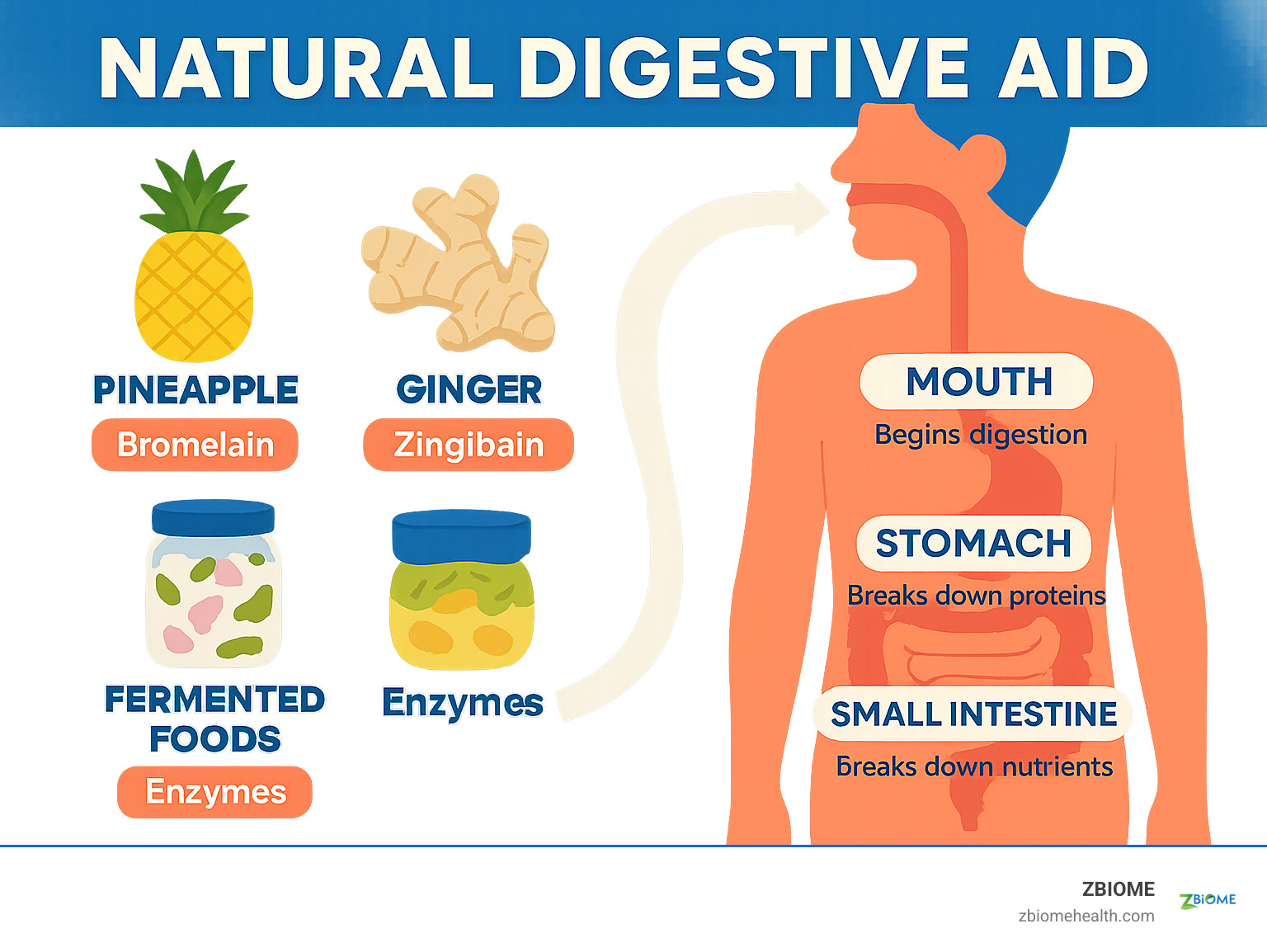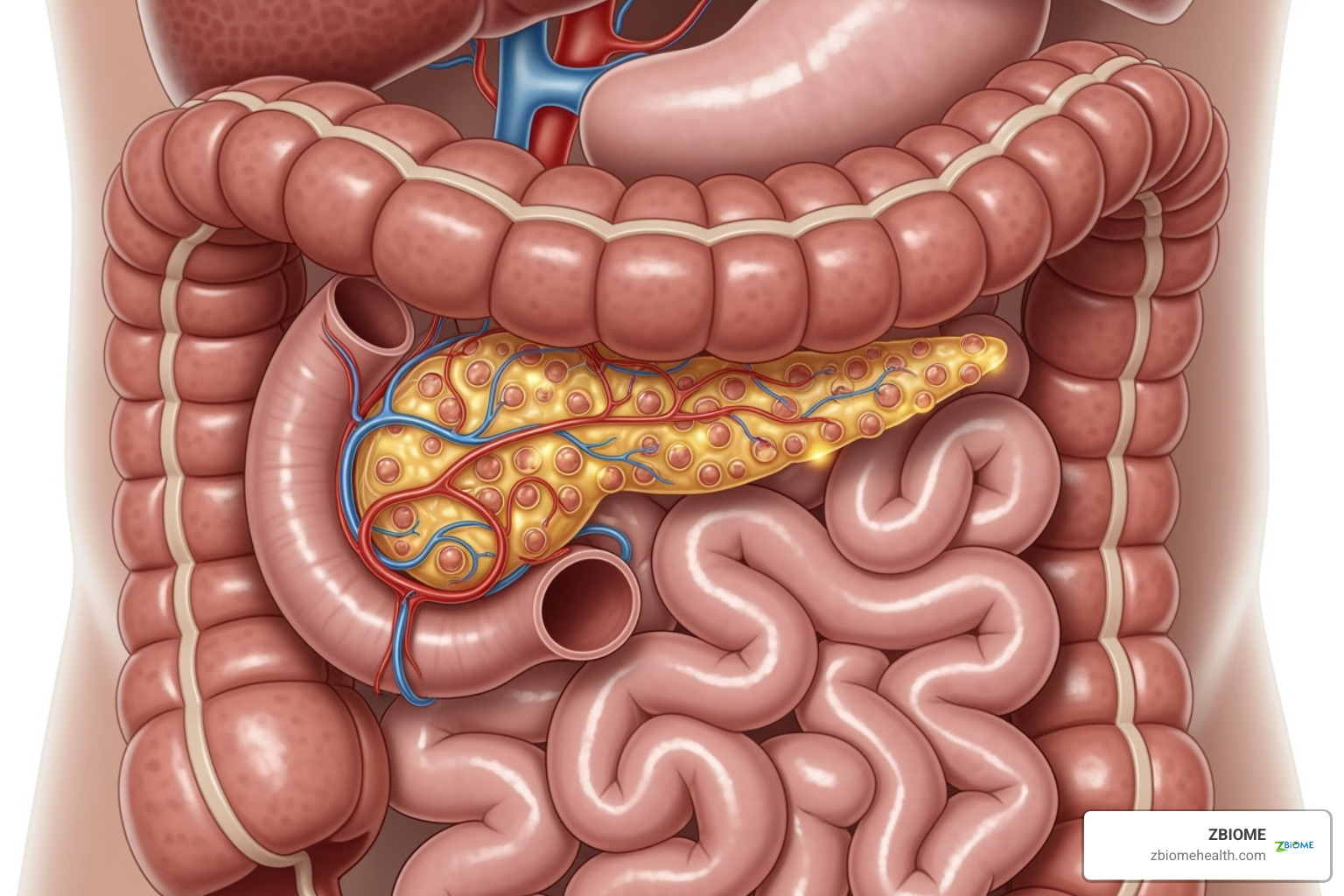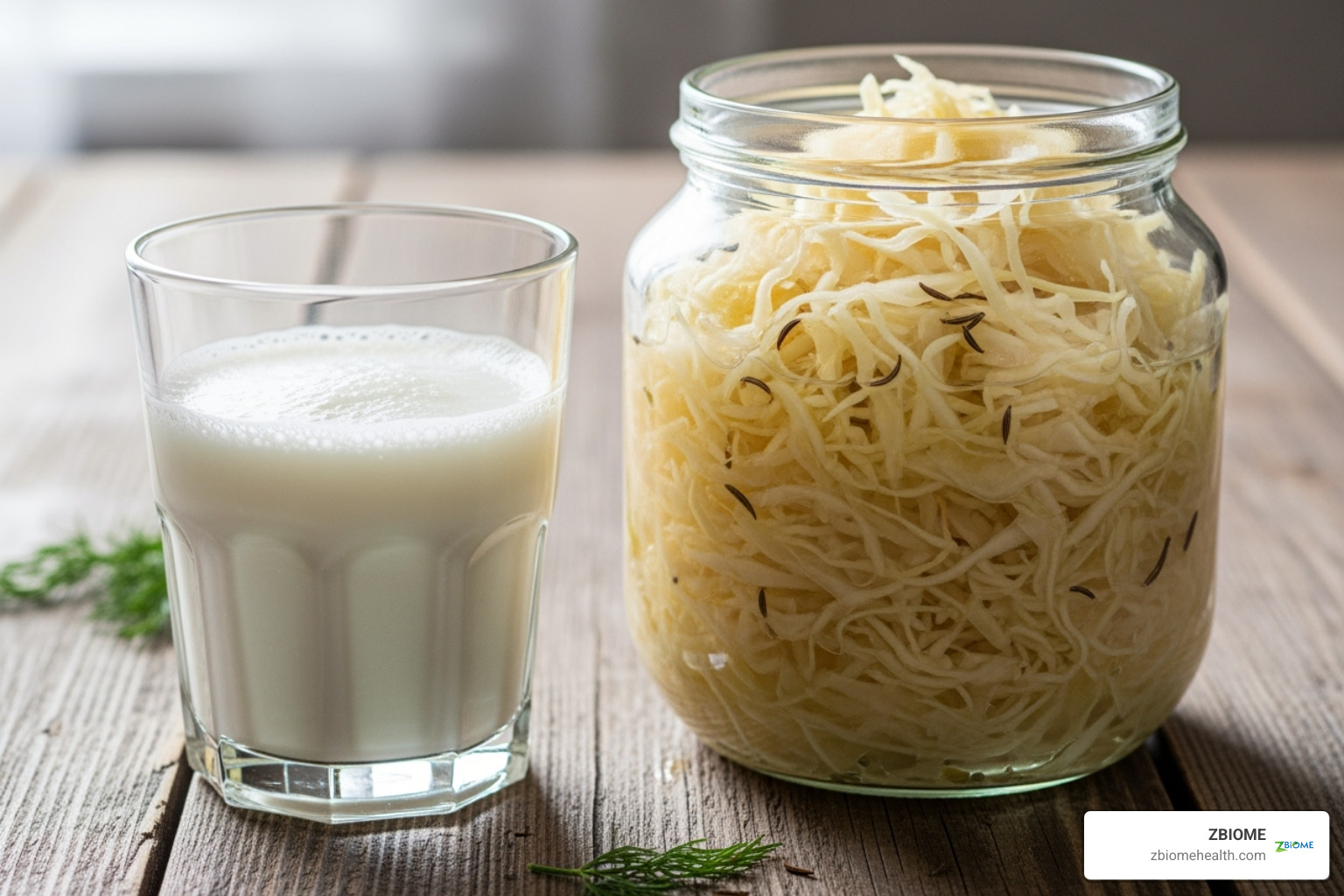Why Natural Digestive Aid Solutions Are More Important Than Ever
Natural digestive aid options have become essential as digestive discomfort reaches epidemic levels. Nearly two-thirds of U.S. adults report experiencing at least one gastrointestinal issue in the past week - from bloating and gas to heartburn and irregular bowel movements.
Quick Natural Digestive Aid Solutions:
- Enzyme-rich fruits: Pineapple (bromelain), papaya (papain), mango (amylase)
- Fermented foods: Kefir, sauerkraut, kimchi for probiotics and enzymes
- Kitchen staples: Ginger (zingibain), raw honey (multiple enzymes)
- Healthy fats: Avocado (lipase) for fat digestion
- Fiber sources: Bananas, psyllium husk for digestive regularity
The modern lifestyle - with processed foods, stress, and environmental factors - has disrupted our natural digestive processes. While our bodies produce digestive enzymes naturally through the pancreas, stomach, and small intestine, many people experience enzyme insufficiency as early as age 25.
This creates a perfect storm: higher demand for digestive support meets decreased natural enzyme production. The result? Millions of people struggling with uncomfortable symptoms after meals.
But here's the good news - nature provides powerful solutions. Certain foods contain the same enzymes our bodies need to break down proteins, fats, and carbohydrates. Others support our gut bacteria or provide fiber for healthy elimination.
A food-first approach offers several advantages over synthetic supplements. These natural options are generally safer, more affordable, and come with additional nutrients your body can use. Plus, they're not subject to the same regulatory gaps that affect over-the-counter digestive enzyme supplements.
I'm Tarek El Ali, a healthcare consultant with experience in pharmaceuticals and immunology, including research on how natural digestive aid solutions can support optimal gut health. My work has focused on translating complex clinical insights into practical strategies that improve patient outcomes and digestive wellness.

The Science of Digestion: Understanding Your Body's Enzymes
Your stomach is growling, and you're about to dive into your favorite meal. But have you ever wondered what happens next? The moment food hits your mouth, an incredible biological orchestra begins playing - and the star performers are digestive enzymes.
Think of digestive enzymes as your body's personal team of molecular chefs. These specialized proteins work like tiny, super-efficient scissors, snipping apart large food molecules into smaller pieces your body can actually use. Without them, even the most nutritious meal would just pass right through you, leaving you malnourished despite eating plenty.
The magic starts before you even take your first bite. Just thinking about food triggers your mouth to produce saliva loaded with enzymes. As your meal travels through your digestive system, your stomach, small intestine, and especially your pancreas - the true enzyme powerhouse - release wave after wave of these molecular helpers.
This coordinated effort ensures that every bite gets broken down properly. When the system works well, you feel energized and comfortable after eating. When it doesn't, you might experience bloating, gas, or that heavy feeling that makes you want to unbutton your pants. Understanding this process is key to finding the right natural digestive aid for your needs.
You can dive deeper into this fascinating process at the National Institute of Diabetes and Digestive and Kidney Diseases, which offers detailed insights into how your digestive system works.

What Are the Main Types of Digestive Enzymes?
Your body produces several types of digestive enzymes, each with its own specialty. It's like having different tools in a toolbox - you wouldn't use a hammer to tighten a screw, and your body doesn't use the same enzyme to break down bread and steak.
Amylase is your carbohydrate champion. This enzyme tackles complex carbohydrates and starches from foods like bread, pasta, rice, and potatoes. It breaks them down into simple sugars like glucose that your body can quickly absorb for energy. You'll find amylase working hard in your saliva and pancreatic juices.
Protease handles the heavy lifting when it comes to proteins. Whether you're eating chicken, beans, or cheese, protease enzymes break down these proteins into smaller pieces called peptides, then into individual amino acids. These amino acids become the building blocks for everything from your muscles to your hormones. Different types of protease work in your stomach (like pepsin) and small intestine.
Lipase is your fat-digesting specialist. This enzyme breaks down dietary fats from foods like avocados, nuts, and olive oil into smaller fatty acids and glycerol that your body can absorb. Without enough lipase, fat digestion becomes problematic, often leading to uncomfortable symptoms and poor nutrient absorption.
Beyond these big three, you have other important players. Lactase works specifically in your small intestine to break down lactose, the sugar in dairy products. When your body doesn't make enough lactase, you experience lactose intolerance - hello, bloating and gas after that ice cream! Sucrase also works in your small intestine, breaking down table sugar (sucrose) into glucose and fructose.
These enzymes work as a coordinated team, ensuring that every macronutrient in your meal gets properly processed and absorbed.
What Causes Digestive Enzyme Insufficiency?
Sometimes your body's enzyme production falls short of what you need. This condition, called digestive enzyme insufficiency, can turn mealtime from pleasure into discomfort. Understanding what causes this can help you recognize when you might need additional support.
Chronic pancreatitis tops the list of causes. This long-term inflammation damages the pancreatic cells responsible for enzyme production, significantly reducing their output. Cystic fibrosis, a genetic condition, creates thick mucus that blocks pancreatic ducts, preventing enzymes from reaching your small intestine. About 90% of people with cystic fibrosis experience pancreatic enzyme insufficiency.
Here's something that might surprise you: aging affects enzyme production earlier than most people realize. Your body's ability to produce certain pancreatic enzymes can start declining as early as age 25. This natural decline helps explain why many people develop digestive issues as they get older.
Gastrointestinal surgeries like gastric bypass or pancreatic procedures can also impact enzyme production and release. Pancreatic cancer can obstruct enzyme flow or destroy the cells that make these crucial proteins.
When your body doesn't produce enough digestive enzymes, you'll likely notice some telltale signs. Belly pain or cramping after meals is common, along with persistent bloating and excessive gas. Diarrhea might become frequent, and you might notice oily, foul-smelling stools - a sign that fats aren't being properly digested. Unexplained weight loss despite eating normally is particularly concerning, as it suggests your body isn't absorbing nutrients effectively.
If you're experiencing persistent symptoms, especially severe ones or unexplained weight loss, it's important to consult with a healthcare provider. They can diagnose underlying conditions and recommend appropriate treatments, which might include prescription enzyme replacement therapy for diagnosed deficiencies.
9 Foods That Serve as a Powerful Natural Digestive Aid
When your digestive system needs backup, you don't have to look far. Nature has packed some incredible foods with the exact same enzymes your body produces. These natural digestive aid options can help break down meals more efficiently and reduce those uncomfortable post-dinner symptoms we all know too well.
The secret is eating these foods raw or lightly processed whenever possible. Heat destroys many delicate enzymes, so that fresh pineapple slice will do more for your digestion than the cooked version in your stir-fry.
Tropical Powerhouses: Pineapple and Papaya
These sunny fruits bring serious digestive power to your plate, especially when it comes to breaking down proteins.
Pineapple contains a group of enzymes called bromelain that excel at chopping up protein molecules into smaller, easier-to-absorb pieces. Ever wonder why your mouth feels tingly after eating fresh pineapple? That's bromelain literally breaking down the proteins in your mouth! This same process happens in your stomach, making protein digestion smoother and more efficient. Scientific research on bromelain's digestive effects shows it can also help reduce inflammation throughout your digestive tract.
Papaya brings its own protein-busting enzyme called papain to the table. This powerful enzyme works similarly to bromelain, helping your body tackle everything from chicken to beans with greater ease. Many people find that eating fresh papaya helps relieve constipation and reduces that heavy, bloated feeling after meals. Like pineapple, papaya's enzymes are so effective that they're used commercially as meat tenderizers.

Everyday Fruits and Veggies: Mango, Banana, and Avocado
You don't need exotic ingredients to give your digestion a boost. Some of the best natural digestive aid foods are probably sitting in your kitchen right now.
Mango gets sweeter as it ripens for a fascinating reason - its amylase enzymes are working overtime, breaking down complex starches into simple sugars. This makes ripe mangoes not only tastier but also easier on your digestive system. Those same amylases help your body process other carbohydrates in your meal too.
Bananas are digestive multitaskers. They contain both amylase and glucosidases, enzymes that team up to break down carbohydrates into energy your body can actually use. The riper the banana, the more active these enzymes become. Plus, bananas provide gentle fiber that keeps things moving smoothly through your system without causing gas or discomfort.
Avocado isn't just about healthy fats - it also contains lipase, the exact enzyme your pancreas makes to digest fats. This makes avocados particularly helpful when you're eating a rich meal. The lipase helps your body break down and absorb those beneficial fats more efficiently. More on the benefits of avocados shows just how powerful this creamy fruit can be for overall health.
Fermented Wonders: Kefir and Sauerkraut
Fermented foods are like getting two digestive aids in one package - beneficial bacteria plus enzymes created during the fermentation process.
Kefir is a fermented milk drink that's packed with lipase, proteases, and lactase. The lactase is particularly exciting if you struggle with dairy - it actually helps break down the lactose that normally causes problems. Many people who can't tolerate regular milk find they can enjoy kefir without any digestive upset. The fermentation process pre-digests much of the lactose and adds enzymes that continue working in your gut.
Sauerkraut transforms humble cabbage into a digestive powerhouse through fermentation. This process creates enzymes that help break down food while also populating your gut with beneficial bacteria. The key is choosing raw, unpasteurized sauerkraut - the pasteurization process kills both the helpful bacteria and the enzymes. Look for it in the refrigerated section rather than shelf-stable jars. Opening up the Power of Zbiome: Your Guide to Probiotic Wellness and Gut Health explains how fermented foods support your entire digestive ecosystem.

Kitchen Staples: Ginger and Raw Honey
These common ingredients pack surprising digestive punch and probably deserve more credit than they get.
Ginger contains an enzyme called zingibain that helps break down proteins, but that's just the beginning of its digestive magic. Ginger also stimulates your stomach muscles, helping food move through your system more efficiently. This is why ginger is so famous for settling upset stomachs and reducing nausea. Effects of ginger on gastric emptying and motility in healthy humans demonstrates how ginger actually speeds up gastric emptying - meaning food doesn't sit heavy in your stomach as long. Some research even suggests ginger might encourage your body to produce more of its own digestive enzymes.
Raw honey contains several enzymes including diastases, invertases, and proteases that help break down starches, sugars, and proteins. The catch is that it must be raw and unfiltered - processed honey has been heated, which destroys these delicate enzymes. While raw honey isn't as enzyme-rich as some fruits, it offers gentle digestive support with a touch of sweetness that makes it easy to incorporate into your routine.
Digestive Enzymes vs. Probiotics: What's the Difference?
When we talk about gut health and natural digestive aid options, two terms often come up: digestive enzymes and probiotics. While both are vital for a happy gut, they play distinct roles. It's like comparing the construction crew to the maintenance team of a building – both are essential, but their jobs are different!
Think of it this way: if your digestive system were a restaurant kitchen, digestive enzymes would be the sharp knives that chop up your food into tiny, manageable pieces. Meanwhile, probiotics would be the friendly kitchen staff that keep everything clean, organized, and running smoothly behind the scenes.
| Feature | Digestive Enzymes | Probiotics |
|---|---|---|
| Function | Break down food molecules into absorbable nutrients | Support beneficial bacteria balance in the gut |
| Source | Naturally produced by body; found in certain foods | Live microorganisms from fermented foods or supplements |
| Primary Purpose | Improve nutrient absorption and reduce digestive discomfort | Maintain healthy gut microbiome and immune function |
Digestive enzymes are proteins that break down food into smaller components your body can actually use. When you eat a piece of chicken, enzymes like protease slice those proteins into amino acids. When you bite into an apple, amylase transforms those complex carbs into simple sugars. Without enough enzymes, food just sits there like puzzle pieces that don't fit together.
Probiotics, on the other hand, are live bacteria – the good kind that actually help you feel better. These microscopic helpers live in your gut and work around the clock to crowd out harmful bacteria, support your immune system, and even produce some enzymes of their own. They're like having a team of tiny bodyguards protecting your digestive tract.
Here's where it gets interesting: these two powerhouses actually work together in beautiful harmony. Your gut bacteria can produce certain enzymes, while proper enzyme function creates an environment where beneficial bacteria can thrive. It's a synergistic relationship that supports overall gut health balance.
The best part? You don't have to choose between them. Many people benefit from supporting both their enzyme production and their gut microbiome. For those looking for comprehensive digestive support, products like Zbiome combines probiotics, prebiotics, and enzymes for digestive support in one convenient solution, addressing multiple aspects of digestive wellness at once.
Understanding this difference helps you make better choices for your digestive health. Whether you need more enzyme support, probiotic reinforcement, or both, knowing what each one does makes it easier to find the right natural digestive aid approach for your unique needs.





